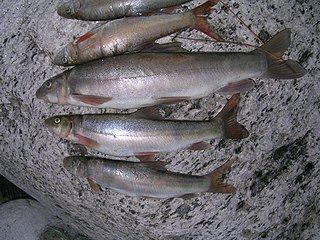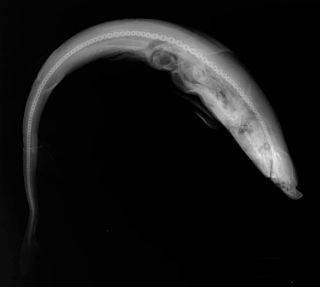
A flatfish is a member of the ray-finned demersal fish order Pleuronectiformes, also called the Heterosomata, sometimes classified as a suborder of Perciformes. In many species, both eyes lie on one side of the head, one or the other migrating through or around the head during development. Some species face their left sides upward, some face their right sides upward, and others face either side upward.

Clupeiformes is the order of ray-finned fish that includes the herring family, Clupeidae, and the anchovy family, Engraulidae. The group includes many of the most important forage and food fish.

Cobitidae, also known as the true loaches, is a family of Old World freshwater fish. They occur throughout Eurasia and in Morocco, and inhabit riverine ecosystems. Today, most "loaches" are placed in other families. The family includes about 260 described species. New species are being described regularly.

The mullets or grey mullets are a family (Mugilidae) of ray-finned fish found worldwide in coastal temperate and tropical waters, and some species in fresh water. Mullets have served as an important source of food in Mediterranean Europe since Roman times. The family includes about 78 species in 26 genera.

Ophichthidae is a family of fish in the order Anguilliformes, commonly known as the snake eels. The term "Ophichthidae" comes from Greek ophis ("serpent") and ichthys ("fish"). Snake eels are also burrowing eels. They are named for their physical appearance, as they have long, cylindrical, snake-like bodies. This family is found worldwide in tropical to warm temperate waters. They inhabit a wide range of habitats, from coastal shallows and even rivers, to depths below 800 m (2,600 ft). Most species are bottom dwellers, hiding in mud or sand to capture their prey of crustaceans and small fish, but some are pelagic.

Gymnothorax is a genus of fish in the family Muraenidae found in Atlantic, Indian, and Pacific Oceans. With more than 120 species, it the most speciose genus of moray eels.

Labeo is a genus of carps in the family Cyprinidae. They are found in freshwater habitats in the tropics and subtropics of Africa and Asia.

Rhinogobius is a genus of primarily freshwater gobies in the family Oxudercidae, native to tropical and temperate parts of eastern Asia. Most are small, streamlined in shape, and often sexually dimorphic. Few are of commercial importance, but R. duospilus is fairly widely traded as an aquarium fish.

Schizothorax is a genus of cyprinid fish found in southern and western China, through northern South Asia (Himalaya) and Central Asia, to Iran, with a single species, S. prophylax, in Turkey. They are primarily found in highland rivers, streams and lakes, although a few species occur in lower-lying locations, like Lake Balkhash and lakes of the Sistan Basin. Their scientific name means "cloven-breast", from Ancient Greek schízeïn (σχίζειν) 'to cleave' and thórax (θώραξ) 'breast-plate'. The western species are typically referred to as marinkas from their Russian name marinka (маринка), while the eastern species are usually called snowtrout. Although they do resemble trouts in habitus this is merely due to convergent evolution and they are by no means closely related apart from both being Teleostei: Cyprinids are in the teleost superorder Ostariophysi, while trouts are in the superorder Protacanthopterygii. Their ancestors must thus have diverged as early as the Triassic, more than 200 million years ago.
Sinocyclocheilus is a genus of freshwater fish in the family Cyprinidae that is endemic to Guangxi, Guizhou and Yunnan in China. Almost all of its species live in or around caves and most of these have adaptions typical of cavefish such as a lack of scales, lack of pigmentation and reduced eyes. Several species have an unusual hunchbacked appearance and some of the cave-dwellers have a "horn" on the back, the function of which is unclear. In contrast, the Sinocyclocheilus species that live aboveground, as well as a few found underground, show no clear cavefish adaptions. They are relatively small fish reaching up to 23 cm (9.1 in) in length. The individual species have small ranges and populations, leading to the status of most of the evaluated species as threatened. Many species populations in the genus have yet to be evaluated by the IUCN.

Cobitis is a genus of small freshwater fish in the family Cobitidae from temperate and subtropical Eurasia. It contains the "typical spiny loaches", including the well-known spined loach of Europe. Similar spiny loaches, occurring generally south of the range of Cobitis, are nowadays separated in Sabanejewia.

Hemimyzon is a genus of freshwater ray-finned fish belonging to the family Balitoridae, the river or hillstream loaches. The species in this genus are found in eastern Asia.

Triplophysa is a genus of fish in the family Nemacheilidae found mainly in and around the Qinghai-Tibet Plateau in China, as well as inland waters of the larger part of central Asia. They can be distinguished from other genera of Nemacheilidae by marked sexual dimorphism, including the development of nuptial tubercles on breeding males. Currently, the genus is a mixed assemblage of species. Some lineages have been identified and treated as subgenera, but as Wikipedia follows Fishbase for fish species all but Hedinichthys have been treated as subgenera in Wikipedia, although Kottelat in his revision of the loaches did recognise them as valid. FishBase, however, includes these in Triplophysa without specifying subgenera and treats the names given by Kottelat as synonyms.

Paragaleus is a genus of weasel shark in the family Hemigaleidae. This genus has a rounded or slightly pointed snout, short gill slits, and a broadly arched mouth. The upper teeth have long cusps, and no toothless spaces occur at the jaw midlines. The dorsal and pelvic fins and the lower caudal lobe are not falchate in shape. Known fossil species include P. pulchellus and P. antunesi.

Opsariichthys is a genus of cyprinid fish found in freshwater habitats in Mainland China, Taiwan, Japan, Korea, and Vietnam. There are currently 12 described species in the genus.
Sinilabeo is a genus of cyprinid freshwater fish found in China and Vietnam.

Pseudogobius is a genus of fish in the goby family, Gobiidae. It is widely distributed in tropical and temperate regions of the Indian and western Pacific Oceans. Species occur in freshwater and estuarine habitat types, such as mangroves and seagrass beds.
Ptychidio jordani, the ratmouth barbel, is a species of freshwater, ray-finned fish from the carp family, Cyprinidae. It is endemic to the Pearl River drainage system, purported records from Taiwan being considered extremely doubtful. It has been a highly sought species for fisheries but the population has declined to such an extent that it is now rarely caught and the damming of its native streams and rivers is now the chief threat to this species. This species is found in fast flowing, clear, streams and rivers flowing over gravel substrates, spawning in rapids. It is a demersal species which feeds on molluscs and algae. It is now a protected species in Yunnan but this little known species requires further research to determine how best to conserve it. It grows to a maximum size of 33 cm (13 in). The specific name jordani was applied by George S. Myers in honor of ichthyologist David Starr Jordan in appreciation of his friendship and kindness to Myers.
Ptychidio longibarbus is a species of cyprinid of the genus Ptychidio. It inhabits China, has a maximum length of 16.8 centimetres (6.6 in) and is considered harmless to humans.
Ptychidio macrops, the bigeye ratmouthed barbel, is a species of cyprinid of the genus Ptychidio. It inhabits China, has a maximum length of 20.1 centimetres (7.9 in) and is considered harmless to humans.














